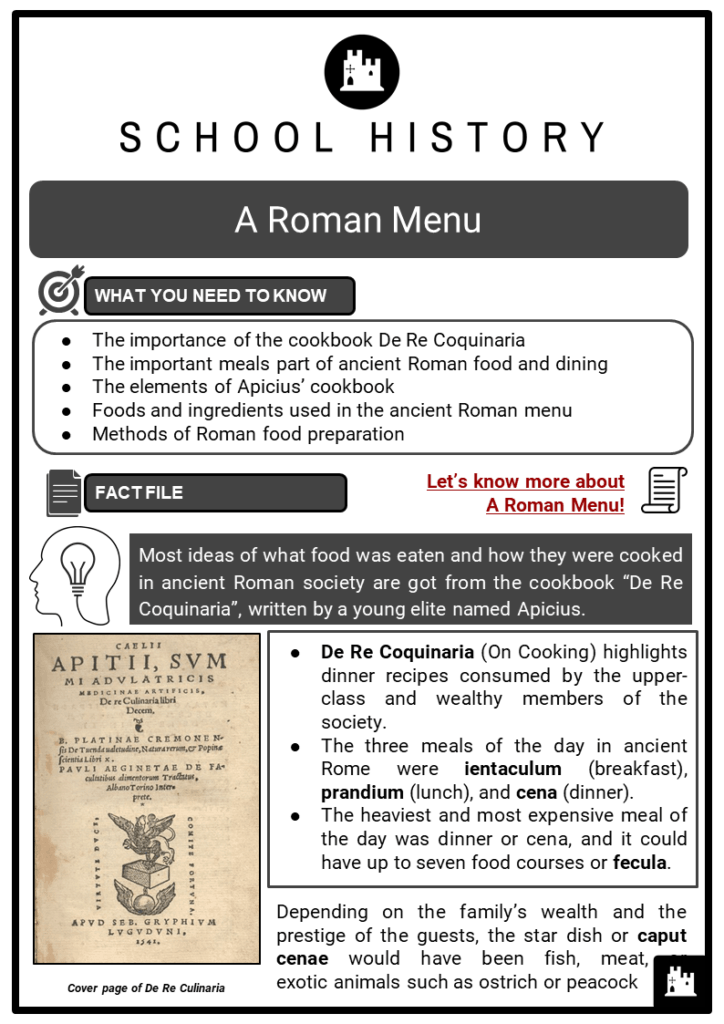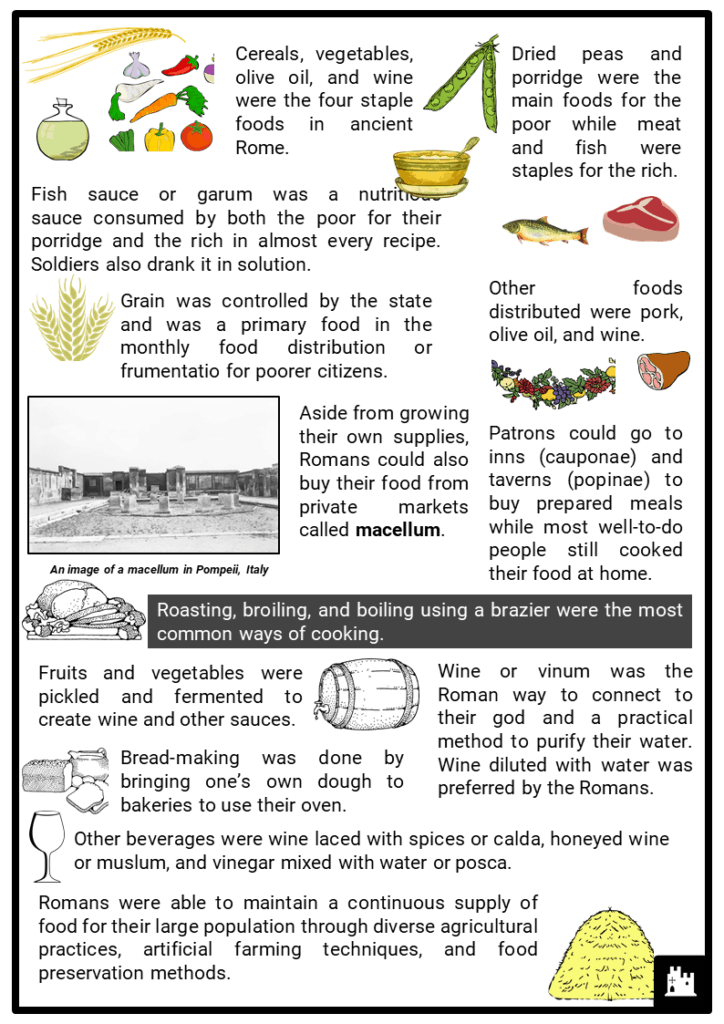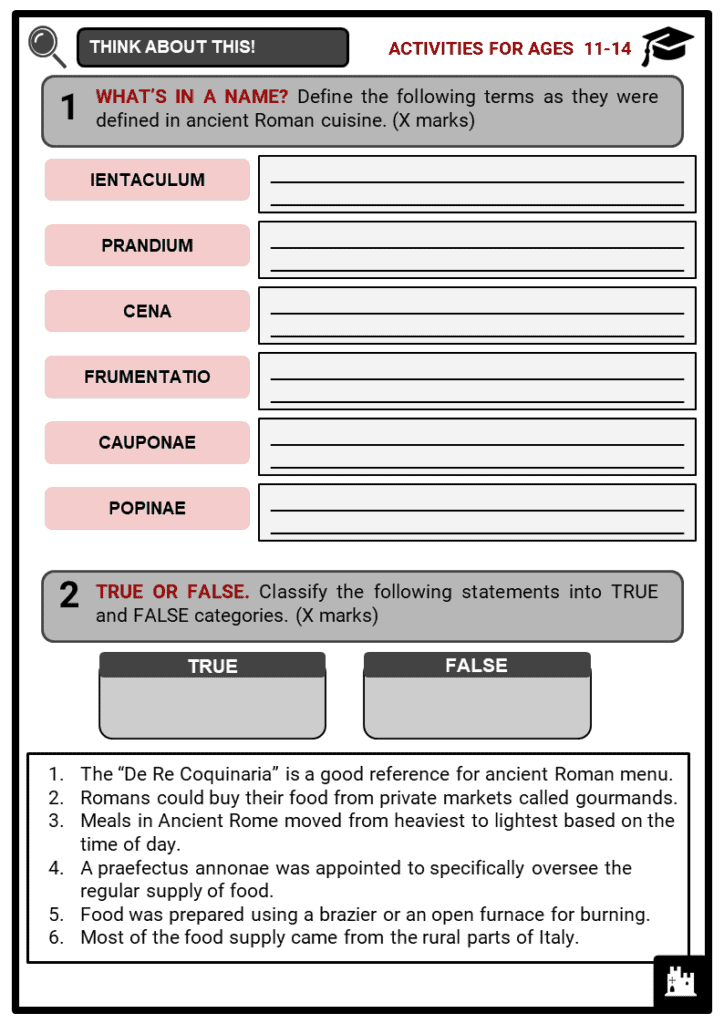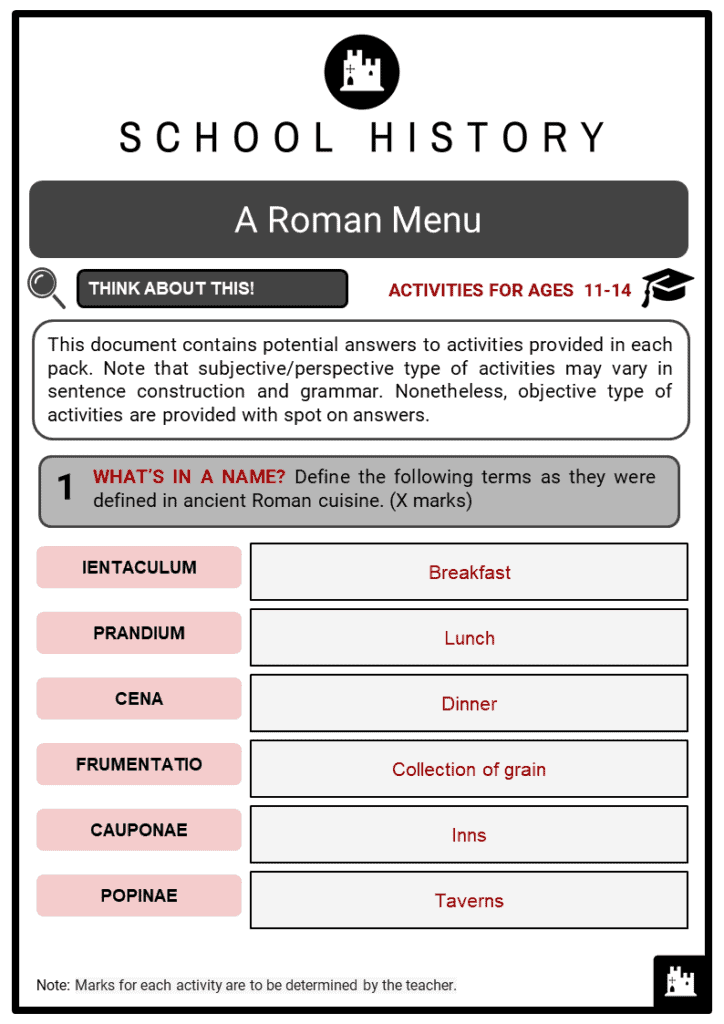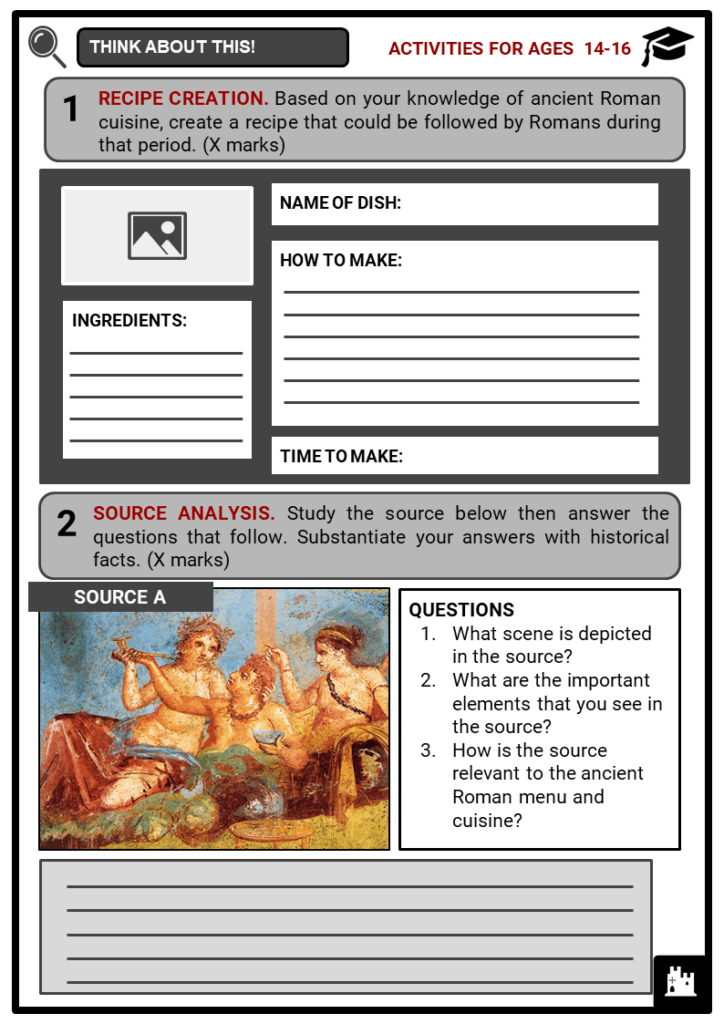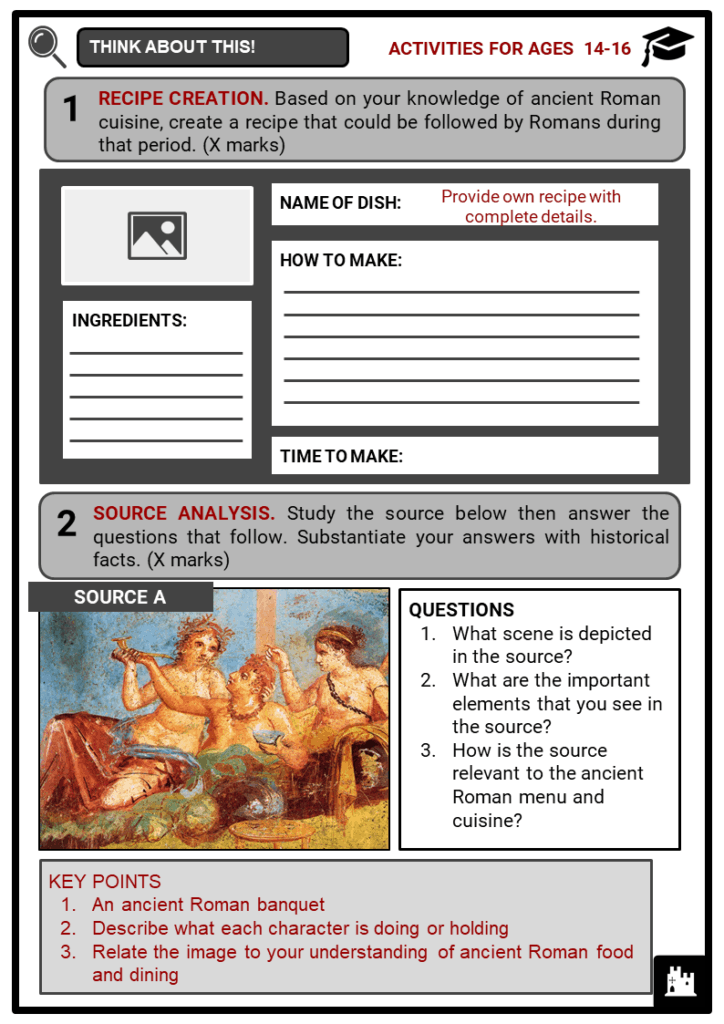Download A Roman Menu Worksheets
Do you want to save dozens of hours in time? Get your evenings and weekends back? Be able to teach A Roman Menu to your students?
Our worksheet bundle includes a fact file and printable worksheets and student activities. Perfect for both the classroom and homeschooling!
Table of Contents
Add a header to begin generating the table of contents
Summary
- The importance of the cookbook De Re Coquinaria
- The important meals part of ancient Roman food and dining
- The elements of Apicius’ cookbook
- Foods and ingredients used in the ancient Roman menu
- Methods of Roman food preparation
Key Facts And Information
Let’s know more about A Roman Menu!
- Most ideas of what food was eaten and how they were cooked in ancient Roman society are got from the cookbook “De Re Coquinaria”, written by a young elite named Apicius.
- De Re Coquinaria (On Cooking) highlights dinner recipes consumed by the upper-class and wealthy members of the society.
- The three meals of the day in ancient Rome were ientaculum (breakfast), prandium (lunch), and cena (dinner).
- The heaviest and most expensive meal of the day was dinner or cena, and it could have up to seven food courses or fecula.
- Depending on the family’s wealth and the prestige of the guests, the star dish or caput cenae would have been fish, meat, or
exotic animals such as ostrich or peacock - Cereals, vegetables, olive oil, and wine were the four staple foods in ancient Rome.
- Dried peas and porridge were the main foods for the poor while meat and fish were staples for the rich.
- Fish sauce or garum was a nutritious
sauce consumed by both the poor for their porridge and the rich in almost every recipe. Soldiers also drank it in solution. - Grain was controlled by the state and was a primary food in the monthly food distribution or frumentatio for poorer citizens.
- Other foods distributed were pork, olive oil, and wine.
- Aside from growing their own supplies, Romans could also buy their food from private markets called macellum.
- Patrons could go to inns (cauponae) and taverns (popinae) to buy prepared meals while most well-to-do people still cooked their food at home.
- Roasting, broiling, and boiling using a brazier were the most common ways of cooking.
- Fruits and vegetables were pickled and fermented to create wine and other sauces.
- Wine or vinum was the Roman way to connect to their god and a practical method to purify their water. Wine diluted with water was preferred by the Romans.
- Bread-making was done by bringing one’s own dough to bakeries to use their oven.
- Other beverages were wine laced with spices or calda, honeyed wine or muslum, and vinegar mixed with water or posca.
- Romans were able to maintain a continuous supply of food for their large population through diverse agricultural practices, artificial farming techniques, and food preservation methods.
Apicius’ cookbook
- Marcus Gavius Apicius was a known member of the elite and a model gourmand (foodie) during the reign of Emperor Tiberius (14-37 CE) in Ancient Rome.
- While he was not a cook himself, his knowledge and love for food led him to compose the only known cookbook to have survived the ancient Greco-Roman world called “De Re Coquinaria” (On Cooking).
- The book contains over 500 recipes of extravagant foods, the location of the desired ingredients, and some notes on presentation of food and remedies for stomach aches.
- Written primarily for trained chefs and wealthy members of society, the recipes in Apicius’ cookbook reflect the height of the Roman empire and celebrate the extravagance and the fruits of their conquests.
- Expensive meats, use of slave cooks, and luxurious banquets and meals characterised the upper-class Roman society, which Apicius knew very well.
- In the end, however, his expensive lifestyle drained his household revenues and made it hard to continue his culinary lifestyle.
- Apicius’ downfall led him to commit suicide.
Roman meals and banquets
- Meals in Ancient Rome moved from lightest to heaviest based on the time of day.
- First came breakfast or ientaculum, consisting of just bread and salt but occasionally with fruit and cheese.
- The lunchtime meal or prandium consisted of fish or eggs with vegetables.
- Most people, at least those who could afford it, saved themselves for the evening meal or cena. The cena could be a grand social gathering lasting several hours.
- The famous pictures in history books of rich people eating at low tables with couches on three sides in a triclinium or dining room exactly depict a cena. It consisted of three parts served with an unlimited number of dishes for each.
- The first course, or gustatio, was served with eggs, shellfish, dormice and olives, typically paired with a cup of wine diluted with water and sweetened honey (mulsum).
- Following these starters was the main course or mensae primae, which may have included up to seven courses (fecula), including the star dish, the caput cenae.
- The main dish was generally meat or fish, with a variation of the most exotic dishes such as a whole roast pig, an ostrich, or a peacock, depending on the household wealth and the guests of the evening.
Foods and ingredients
- Ancient Mediterranean cuisine is considered to be one of the healthiest in history. It revolved around four staples: cereals, vegetables, olive oil and wine.
- Generally only the rich could afford seafood, cheese, eggs, meats, and many types of fruits on their table.
- The bulk of people’s diet was made up of cereals with wheat and barley as the primary ingredients in bread and porridge. Bread was a staple food in Ancient Rome, eaten by all social classes.
- Roman bread varied in quality depending on the kind of flour used. Some of the kinds of bread enjoyed by the Romans were round, flat loaves made of emmer and salt (lentaculum), fatty cake bread made from the seeds of
wheat grain (artolaganus), and honey and wine-soaked bread (picenum). - As for vegetables, the Romans grew beans, peas, onions, asparagus, mushrooms, turnips, and brassicas or cabbages.
- Poorer households mostly rely on dried peas.
- Olives and olive oil were a staple food and an important source of fats.
- Apples, figs, and grapes were the most commonly available fruits.
- Grapes were eaten fresh, and as raisins, and made into unfermented juice known as defrutum.
- Meat and fish were expensive for most Romans and so were commonly prepared in small cuts or sausages.
- Poultry and wild game such as rabbit, hare, boar, and deer were available from large enclosed areas of forests.
- Alternatives were pork, veal, mutton, and goat.
- A variety of birds such as geese, ducks, blackbirds, doves, magpies, and quails were also valued for their meat.
- Fish needed to be preserved as the supply was irregular.
- Fish sauce or garum was also famous, which was made from fish guts and small fish, which were salted and left in the sun.
- Garum production was a big business, especially in Pompeii.
- Aside from being a staple addition in their foods (the poor poured it into their porridge and the rich used it in every recipe), garum also helped soldiers to stay awake during their conquests as they drank it in solution.
Supply and distribution
- Being a huge city, Rome had different systems for food supply and distribution to ensure that people were fed.
- Most foodstuffs came from mainland Italy and the larger islands such as Sicily and Sardinia.
- In the Republic, magistrates were able to ensure food from subject provinces and allied states.
- Tiberius Sempronius Gracchus, a populist Roman politician, was known for his agrarian reforms.
- He established a monthly quota or frumentatio of grain set at a reasonable fixed price for citizens.
- Grain was controlled by the state as it was a form of tax in Italy and Africa.
- A praefectus annonae was appointed to specifically oversee the regular supply of food, especially grain.
- When the empire started to weaken, rich private individuals and the Church took over some of the responsibilities of maintaining a regular food supply.
- Later, olive oil, pork, and wine were also given out as part of frumentatio for poorer citizens.
- Citizens could also buy their food at a private market called a macellum, if they did not grow their own supplies.
- One of the most famous and biggest locations for a marketplace was Trajan’s Market, a sort of ancient shopping mall in Rome.
Cooking and preparation
- Roman towns had inns (cauponae) and taverns (popinae) where people could buy prepared meals and enjoy a drink of cheap wine.
- However, these places were also known for lacking sanitation and for prostitution, so more well-to-do people still had cooking as a household activity.
- People would bring their own dough for bread-making to bakeries where they could use their oven.
- Using a brazier or an open furnace for burning, food was roasted, broiled, and boiled.
- Fruits and vegetables were pickled in either brine or vinegar or preserved in wine, grape juice, or honey to increase its shelf life.
- Generally, the art of good cooking was a matter of mixing condiments to create tasty and unique sauces using wine, oils, vinegar, herbs, spices, and meat or fruit juices.
Drinks
- Wine or vinum was an important part of the Romans’ everyday life, from morning to evening, both on a spiritual and a practical level.
- As an all-natural process, wine fermentation connected the Romans to their gods such as Bacchus, the god of agriculture, wine, and fertility.
- They also used the cleansing properties of wine in their water, so a diluted mixture of water and wine was consumed even by infants.
- As a social symbol, it was also preferred to drink a watered-down version of wine as a strong, undiluted wine was a mark of barbarism and low class in Ancient Rome.
- As such, wine was a drink primarily tied to sophistication and class privilege.
- Other ancient Roman beverages were warm water and wine laced with spices (calda), honeyed wine (muslum), and vinegar mixed with water (posca).
- Posca was considered the common people’s energy drink with its mixture of acidity and slight alcohol content that reduced the bacteria and made it safer than drinking straight water.
Conclusion
- Ancient Rome, with its large population, utilised their knowledge of diverse agricultural practices, artificial farming techniques, and food preservation methods to ensure a sustainable supply of food.
- As today, access to particular quantity and quality of food depended on the social class and status of the Romans.
- The Republic, through its reforms and policies, was able to utilise their surplus of resources to cater to the needs of their people.
- The ancient Roman menu will always be known for its nutritious and sophisticated characteristics reflective of the triumphs of one of the most successful empires in history.

